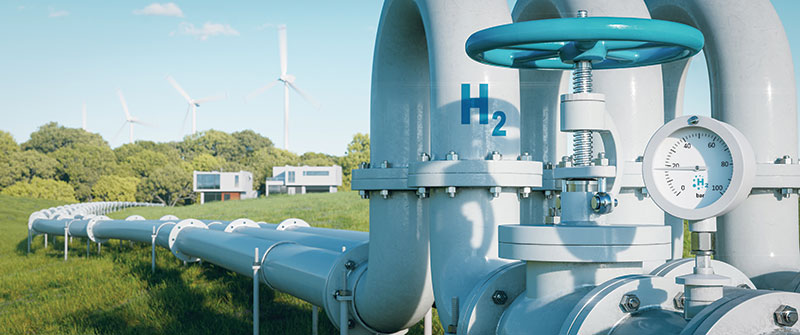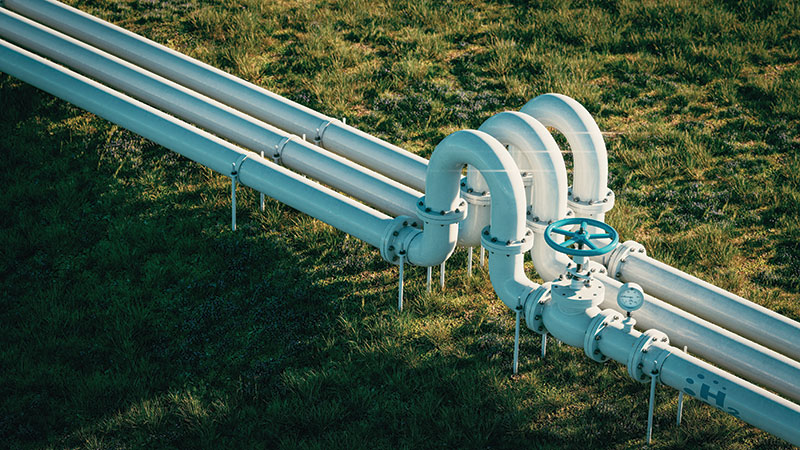December 2022, Vol. 249, No. 12
Features
Repurposing Gas Networks Key to Fulfill Europe’s Hydrogen Ambitions
By Andreas Walstad, P&GJ European Correspondent
(P&GJ) — The European Union (EU) has set a target of 11 million tons (10 million tonnes) of renewable hydrogen production domestically by 2030 in a bid to replace fossil fuels in hard-to-abate sectors such as heavy industry and transport.
This will require a continued scaling up of wind and solar projects as well as an accelerated roll out of electrolyzer capacity. But the challenges don’t stop there. Transporting the hydrogen to demand centers, sometimes over long distances, is also an issue that will require large investments and careful planning.
To this end, repurposing existing gas pipelines to carry hydrogen is often mentioned as a solution to the transportation challenge. But how straight-forward is it to convert gas pipelines to hydrogen networks?
A study published by the Agency for the Cooperation of Energy Regulators (ACER) last year found that, as a rule-of-thumb, repurposing does not present insurmountable technical challenges and is cheaper than building new hydrogen networks.
The gas pipelines are already there and “socially accepted,” the ACER report noted. Moreover, technologies for converting the natural gas infrastructure to hydrogen operation are already “largely available and tested.”
However, ACER noted that there is no one-size-fits-all solution for converting natural gas pipelines to carry hydrogen because each case would require detailed and substantiated engineering analysis.
For example, there are still challenges related to the conversion of compressor stations to hydrogen. It is not currently possible to retrofit gas turbo-compressors to handle gas containing more than 40% hydrogen in volumetric terms, the report said. As for costs, ACER noted that hydrogen transportation is expected to be more expensive because it would require about three times the compression power to maintain similar energy flow to natural gas.
Security of Demand
But there are also several other challenges to consider. Security of demand is one of them, as well as the ability to deliver the hydrogen to where it is needed the most, for example to industrial demand centers.
The European gas network consists of more than 124,275 miles (200,000 km) of transmission pipelines, over 1,242,750 miles (2 million km) of distribution network and more than 20,000 compressor and pressure reduction stations. Conversion to hydrogen transmission would need to be gradual and getting the timing right seems essential.
“In our view, pipelines should be fully dedicated to hydrogen. In this context, grid operators would have to repurpose existing pipelines in order to deliver hydrogen from point A to point B,” Nicola Rega, energy director at the Brussels-based trade association European Chemical Industry Council (Cefic), told P&GJ.
“This would require closing existing delivery points to ensure hydrogen will only be delivered to the dedicated consumers — a number that will grow over time and with it the deliveries.”
The European Hydrogen Backbone (EHB), an initiative set up in 2020, which now includes 31 grid operators, envisages five pan-European supply corridors in Europe by 2030 and a mature hydrogen network “stretching toward all directions” by 2040, according to a paper published in April this year.
The five supply corridors envisaged by 2030 are a North Sea corridor, a Nordic and Baltic corridor, a South East Europe and Southwest corridor, and a North Africa and Italy corridor.
This would entail a pipeline network with a total length of 17,400 miles (28,000 km) growing to 32,930 miles (53,000 km) by 2040, largely based on repurposed existing natural gas infrastructure; although, new pipelines would also have to be built.
The North Africa and Italy corridor, for example, would connect hydrogen supply from Tunisia and Algeria through Italy to central Europe, according to plans. This corridor would leverage repurposed existing natural gas pipelines in Italy, Austria, Slovakia and Czechia to import and transport the green hydrogen from North Africa to central Europe. Solar and wind power produced in Tunisia, Algeria and Italy could be converted to green hydrogen to help decarbonize existing industries along the transit route as well as the southern German industrial clusters in Bavaria, the Rhin-Main area and Rhinland, according to the paper.
The investment costs for the European hydrogen network, however, seems a big uncertainty, and the EHB’s estimate for 2040 is a wide range – EUR 80 to 143 billion.
Planning Stage
As for new hydrogen projects, planning is already underway across the continent. In Germany, for example, Gascade and Fluxys have joined forces to develop two hydrogen infrastructure projects in a bid to connect demand centers with onshore and offshore hydrogen production.
One of the projects, entitled “Doing hydrogen,” is a large-scale pipeline project in eastern Germany, planned to be operational by 2027. This involves a 31-mile (50-km), newly built hydrogen pipeline from the area of Rostock on the Baltic Sea going southward as part of the eastern German hydrogen grid.
The second project, AquaDuctus, is a large-scale offshore pipeline project for transporting hydrogen produced from wind farms in the North Sea onto the German onshore hydrogen grid. The first phase of AquaDuctus, connecting the first offshore electrolyzers with the island of Heligoland, is planned to be operational at the end of 2026. The plan is to move up to 1 million tons of hydrogen into Germany by 2035.
Another strategy is the “hydrogen ready” approach, which means building a new pipeline that will first be used for transporting natural gas with hydrogen taking over at a later stage. The newly proposed subsea pipeline between Barcelona and Marseille (BarMar), for example, would fit into this category.
However, hydrogen ready does not necessarily mean that all the hydrogen infrastructure will be in place during the first phase. It could mean, for example, that the new pipeline is capable of transporting hydrogen but that the necessary compressor stations, etc., still need to be built at a later stage.
Blending Option
An alternative to repurposing and new build, at least in the shorter term, is blending natural gas with hydrogen. Italian grid operator Snam is one of the pioneers in the area and has carried out testing with 5% and 10% blending rates. Ten percent hydrogen in the total gas volume transported annually by Snam could mean that 247 Bcf (7 Bcm) of hydrogen is injected into the network every year, according to Snam.
“Basically, the pipeline network is ready for [...] hydrogen transmission.” Ningke Peng, board member and senior vice president of Snam China, told a recent webinar audience.
“We believe actually that the majority of the natural gas infrastructure in Italy is reliable for [hydrogen]. Most of the infrastructure in Europe probably as well,” he said.
Snam is not alone in its belief that blending can offer tangible benefits for security of energy supply and emissions reductions. In the U.K., the Energy Networks Association (ENA) has said that blending up to 20% hydrogen in Britain’s gas grid is possible from 2023, subject to approval from the government.
Others are more skeptical, pointing to potential safety issues and difficulties (for example, industrial importers) to get the exact blending rate they want. They say grid operators cannot guarantee that the hydrogen (H2) molecules, blended with methane (CH4) molecules, will be delivered in the same ratio, leading to commercial, regulatory and technical problems.
Cefic, for example, is not a supporter of blending hydrogen in natural gas.
“Under this approach, guaranteeing the hydrogen being delivered from point A to B is already an issue per se, as molecules would be unevenly distributed across all customers. This leads to a number of additional problems, starting with guaranteeing gas quality to end users,” said Rega.
High Costs
Cost is a major obstacle for hydrogen production and transmission to reach scale.
To this end, the EU has said it will support hydrogen projects financially, and Ursula von der Leyen, the president of the European Commission, recently announced a EUR 3 billion Hydrogen Bank to get the ball rolling.
But a common European regulatory framework for hydrogen networks, including investment incentives, is still missing.
Jan Frederik Braun, senior expert Hydrogen Economy at Fraunhofer, a research organization in Germany, said Europe has huge potential for hydrogen but that it is also falling over its own feet “because you have a lot of countries doing a lot of different things.”
“I think we have to give a big thanks to the Biden administration in the U.S., i.e., for their efforts on the Inflation Reduction Act (IRA), including a 10-year tax credit for hydrogen production and clear carbon intensity rates,” Braun told P&GJ.
“I think that the IRA serves as a serious wake-up call to European policymakers to change course on their complicated – and still in flux, hence unclear – mixture of regulation,” he added.
Braun said Europe needs to get its act together “or it will quickly lose its lead.”
“This can be done by using existing instruments such as H2Global and fleshing out the role of the European Hydrogen Bank,” he added.
H2Global is a German auction-based mechanism set up to address high upfront costs for hydrogen projects. The goal is to conclude long-term purchase contracts on the supply side and short-term sales contracts on the demand side.
The difference between supply prices, production and transport, and demand prices will be compensated using grant funding from the German government, Rega told P&GJ.
The EU’s Hydrogen Bank is expected to be set up in the third quarter of 2022, according to the European Commission’s work program.







Comments